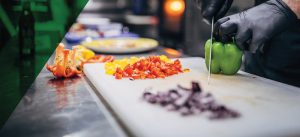— By Chris Gurreri —
How restaurants can rise to the raised expectations of what “clean” means in a post-pandemic world.
The COVID-19 pandemic has heightened everyone’s awareness of everyday actions, from breathing to touching doorknobs. One area that deeply affects the retail and restaurant industry is the general public’s increased expectation of cleanliness in public spaces. Restaurants from the fast-food industry to local cafes have put up signs demonstrating their commitment to health, detailing their mask requirements, social distancing requests and cleaning procedures. In this article, we’ll go through some of the new risks that you, as a member of the restaurant industry, may be running into as the public has raised its expectations of what “clean” means.

Chris Gurreri, Victory Innovations
Although every restaurant is familiar with some level of cleaning and sanitizing surfaces on the regular, it’s certainly a higher priority now. The pandemic has seen many restaurants investing in heavier-duty chemicals, choosing disinfectants with higher kill counts, as opposed to simple soap, water and baking soda.
So, where’s the problem?
First, we need to explain a few basic terms:
- Dwell time, or contact time, refers to the amount of time a disinfectant needs to sit wet on a surface before it’s achieved full efficacy.
- An active ingredient is the ingredient in a chosen cleaner that makes it a sanitizer or disinfectant.
- Food contact, no rinse (FCNR) is a classification used by the EPA; these chemicals are safe to use on food contact surfaces and do not require rinsing after use.
- Food contact, post-rinse required (FCR) is a similar classification, but these chemicals do require a thorough rinse with water after use.
- Hard non-porous (HN) is another EPA classification; these chemicals are for use on hard, non-porous surfaces like doorknobs, faucets and sealed wood.
Let’s talk briefly about why the EPA makes a distinction between food contact surfaces and hard, non-porous surfaces.
The EPA recognizes two active ingredients that can kill COVID-19 that only require a 10-second dwell time: a combination of quaternary ammonium and ethanol. Depending on the formulation type, this chemical is classified for hard non-porous surfaces or for food contact surfaces, post-rinse required. Most chemicals with similar dwell times — 15 or 30 seconds — are designated for the same surface types.
Why is this relevant to you?
If you’re using a strong chemical with a short dwell time on a surface that comes in contact with food, you likely need to be rinsing the surface thoroughly with water — not just wiping it down with a dry cloth. This goes for tabletops, counters, food prep areas and especially dishes and cooking utensils.
 There’s real harm in skipping that rinse step for chemicals like bleach or quaternary ammonium. Quaternary ammonium compounds, or quats, are actually designed to leave behind persistent residues that don’t evaporate. Like any disinfectant, you wouldn’t want to put it in your mouth — but quats stick around on surfaces much longer than other chemicals. It’s very easy for patrons to touch a tabletop or plate, then pick up their sandwich and transfer any chemical particles into their mouth.
There’s real harm in skipping that rinse step for chemicals like bleach or quaternary ammonium. Quaternary ammonium compounds, or quats, are actually designed to leave behind persistent residues that don’t evaporate. Like any disinfectant, you wouldn’t want to put it in your mouth — but quats stick around on surfaces much longer than other chemicals. It’s very easy for patrons to touch a tabletop or plate, then pick up their sandwich and transfer any chemical particles into their mouth.
On the other end of the spectrum are disinfectants classified as food contact, no rinse. This list includes chemicals like ethanol and hypochlorous acid. These disinfectants don’t require rinsing with water after application, even on surfaces that come in contact with food. Most chemicals classified as FCNR require a dwell time of at least 1 minute to reach full efficacy; some require as long as 5 or 10 minutes. One minute might not seem very long, but how long are your servers waiting between spraying the disinfectant and wiping it off tabletops? That practice isn’t just ineffective — it’s probably spreading germs around, since the disinfectant didn’t have enough time to kill the virus particles.
There is one FCNR chemical approved to kill the novel coronavirus with only a 15-second dwell time: a combination of Dodecylbenzenesulfonic acid and L-Lactic acid. This chemical comes in several formulations and can be dispersed with both a traditional handheld trigger sprayer and an electrostatic sprayer.
As you can see, there are many options available to restaurants when it comes to disinfecting. It’s generally best to avoid chemicals that the EPA doesn’t list as food contact safe, especially anything with fragrance. If servers have the time and space to thoroughly rinse surfaces with water, an FCR chemical could be a great option. If the team is crunched for time, your options may be more limited.
To find a disinfectant to fight COVID-19 that fits your business, check out List N, a tool compiled and run by the EPA. You can search with multiple criteria, including surface type, contact time and active ingredient.
— Chris Gurreri is the CEO and co-founder of Victory Innovations, makers of cordless handheld and backpack electrostatic sprayers. Prior to building Victory Innovations, Gurreri worked with some of the most recognized name brands in the world creating opportunities to increase speed and build quality into product launches.
